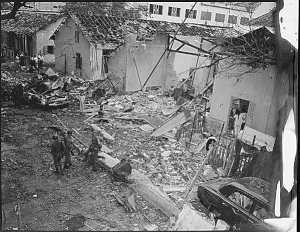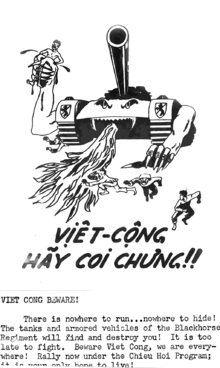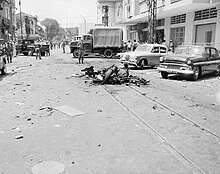Viet Cong
- "NLF" redirects here. For other uses, see NLF (disambiguation)
- "Victor Charlie" redirects here. For other uses, see VC.
| Vietcong or National Liberation Front Việt Cộng or Quân Giải phóng [Liberation Army] | |
|---|---|
 The Brinks Hotel, Saigon, following a Vietcong bombing on Dec. 24, 1964. Two American officers were killed. | |
| Leaders | COSVN: Trần Văn Trà (chairman, 1964-76), Phạm Hùng (Hanoi Politburo member supervising COSVN). NLF: Nguyễn Hữu Thọ (chairman), Huỳnh Tấn Phát (general secretary, vice-chairman), Võ Chí Công, Phung Van Cung (vice-chairman). |
| Dates of operation | 1954—1976 |
| Group(s) | National Liberation Front of South Vietnam Provisional Revolutionary Government of the Republic of South Vietnam (PRG) People's Liberation Armed Forces (PLAF) Alliance of National Democratic and Peace Forces Central Office for South Vietnam (COSVN) |
| Headquarters | Hanoi, North Vietnam (NLF and PRG) Loc Ninh, South Vietnam (COSVN) |
| Active regions | Indochina, with a focus on South Vietnam |
| Ideology | Communist |
| Allies | North Vietnam, China, Soviet Union, Cuba |
| Opponents | South Vietnam United States Ngô Đình Diệm Nguyễn Văn Thiệu |
| Battles and wars | See full list |
The Vietcong (Việt Cộng) was a communist army based in South Vietnam that fought the United States and South Vietnamese governments during the Vietnam War (1959-75). It had both guerrilla and regular army units, as well as a network of cadres who organized peasants in the territory it controlled. Many soldiers were recruited in South Vietnam, but others were attached to the regular North Vietnamese army. The Vietcong was closely allied with the government of North Vietnam. The group was formed in the 1950s by former members of the Vietminh acting on orders from Hanoi. Many of its core members were "regroupees," southern communists who had resettled in the North after the Geneva Accord (1954). Hanoi gave the regroupees military training and sent them back to the South along the Hochiminh Trail in the late 1950s and early 1960s. The Vietcong's best-known action was the Tet Offensive, a massive assault on more than 100 South Vietnamese urban centers in 1968. The offensive riveted the attention of the world's media for weeks, but also overextended the Vietcong. Later communist offensives were conducted primarily by the North Vietnamese army. The group was dissolved in 1976 when North and South Vietnam were officially unified under a communist government.
Names
Việt Cộng is short for Việt Nam Cộng Sản ("Vietnamese communist"). The word appears in Saigon newspapers beginning in 1956.[2] The earliest citation for "Vietcong" in English is from 1957.[3] American soldiers referred to the Vietcong as Victor Charlie or VC. "Victor" and "Charlie" are both letters in the NATO phonetic alphabet. "Charlie" referred to communist forces in general, both Vietcong and North Vietnamese.
In communiqués, the Vietcong used the name National Liberation Front of South Viet-Nam (Mặt trận Dân tộc Giải phóng miền Nam Việt Nam).[4] Many writers shorten this to National Liberation Front (NLF). In 1969, the Vietcong created the "Provisional Revolutionary Government of the Republic of South Vietnam" (Chính Phủ Cách Mạng Lâm Thời Cộng Hòa Miền Nam Việt Nam), abbreviated PRG. Although the NLF was never officially abolished, the Vietcong no longer used the name after PRG was created.
The Vietcong had a "Main Force" (chủ lực) of full-time soldiers. After 1961, this army was officially called the People's Liberation Armed Forces. In common Vietnamese usage, the name was shortened to Quân Giải phóng ("Liberation Army").

History
Origin
By the terms of the Geneva Accord (1954), which ended the Indochina War, France and the Vietminh agreed to a truce and to a separation of forces. The Vietminh became the government of North Vietnam and communist forces "regrouped" there. Non-communist forces regrouped in South Vietnam, which became a separate state. Elections on reunification were scheduled for July 1956. A divided Vietnam left Vietnamese nationalists livid, but it made the country less of a threat to China. Chinese Premier Zhou Enlai negotiated the terms of the ceasefire with France and then imposed them on the Vietminh.
About 90,000 Vietminh were evacuated to the North while 5,000 to 10,000 cadres remained in the South, most of them with orders to refocus on political activity and agitation.[2] The Saigon-Cholon Peace Committee, the first Vietcong front, was founded in 1954 to provide leadership for this group.[2] Front groups were favored by the Vietcong to such an extent that its real leadership remained shadowy, or "faceless," until long after the war was over.[2]
Led by Ngô Đình Diệm, South Vietnam refused to sign the Geneva Accord. Arguing that a free election was impossible under the conditions that existed in communist-held territory, Diệm announced in July 1955 that the scheduled election on reunification would not be held. Diệm launched a largely effective campaign against Vietcong, who were allied with the Hòa Hảo and other dissident groups. France needed soldiers in Algeria to fight rebels there and the last French soldiers left Vietnam in April 1956.[5]

The Sino-Soviet split, which began in 1956, reduced Beijing's influence and allowed Hanoi to play the two communist giants off against each other. In December, the North Vietnamese leadership secretly resolved to take measures to revive the insurgency in the South.[6] Hardliner Lê Duẩn was appointed acting party boss soon afterwards. An assassination campaign, referred to as "armed propaganda" in communist literature, began in April 1957. Tales of sensational murder and mayhem soon crowded the headlines.[2] Seventeen civilians were killed by machine gun fire at a bar in Châu Đốc in July and in September a district chief was killed with his entire family on a main highway in broad daylight.[2] In October 1957, a series of bombs exploded in Saigon and 13 Americans were wounded.[2] French scholar Bernard Fall published an influential article in July 1958 which analyzed the pattern of rising violence and concluded that a new war had begun.[2]
Launches "armed struggle"
The North Vietnamese Communist Party approved a "people's war" on the South in January 1959, a decision confirmed by the Politburo in March. Communist assistance to the Vietcong increased dramatically and the "regroupees" of 1954 were gradually sent to the South via the Hochiminh Trail.[5] In May 1959, the Central Office for South Vietnam was reestablished.[5] COSVN was a military and communist party headquarters for the South, initially located in Tay Ninh Province near the Cambodian border. The "2d Liberation Battalion" ambushed two companies of South Vietnamese soldiers in September 1959, the first large unit military action of the war.[2] This was considered the beginning of the "armed struggle" in communist accounts.[2] An uprising in the Mekong Delta province of Ben Tre in January 1960 and further uprisings in September created "liberated zones" in both the Mekong Delta and in the Central Highlands that were beyond the control of Saigon.[7]

To counter the accusation that North Vietnam was violating the Geneva Accord, the independence of the Vietcong was stressed in communist propaganda. The National Liberation Front was organized in December 1960 as the political wing of the Vietcong. The group's formation was announced by Radio Hanoi and its ten point manifesto called for, "overthrow the disguised colonial regime of the imperialists and the dictatorial administration, and to form a national and democratic coalition administration."[2] In 1962, the People's Revolutionary Party was created as a separate communist party for South Vietnam and "the paramount member" of the NLF.[2]
The Vietcong grew rapidly and an estimated 300,000 members were enrolled in "liberation associations" (affiliated groups) by early 1962.[2] In 1964, Trần Văn Trà, a general in the North Vietnamese army, was appointed chairman of COSVN, the Vietcong's top military position. He served in this position until 1976. COSVN reported to General Nguyễn Chí Thanh, a member of the North Vietnamese Politburo, or ruling council, i.e. not to the NLF. After Thanh's death in 1967, COSVN reported to Politburo member Phạm Hùng, previously Thanh's deputy. In practice, much of Thanh's authority devolved to Trà.
As the insurgency reached a crisis level, the U.S. government, led by President John F. Kennedy, responded by substantially increasing aid to South Vietnam.[7] By mid-1962, there were 12,000 U.S. military advisors in Vietnam.[8] The Vietcong won its first military victory against South Vietnamese forces at Ap Bac in 1963. Soviet aid to North Vietnam soared following a visit to Hanoi by Soviet Premier Aleksei Kosygin in February 1965, including up-to-date surface-to-air missiles.[9] The U.S. would have 200,000 soldiers in South Vietnam by the end of the year.[10] In January 1966, Australian troops uncovered a tunnel complex which had been used by COSVN.[11] Six thousand documents were captured, revealing the inner workings of the Vietcong. COSVN retreated to Mimot in Cambodia.

Notable Vietcong atrocities include 48 killed in the bombing of My Canh floating restaurant in Saigon in June 1965[13] and a massacre of 252 Montagnards in the village of Dak Son in December 1967 using flamethrowers.[14]
Tet Offensive
Although its activities otherwise focused on rural areas, in 1968 the Vietcong conducted a dramatic series of attacks on urban areas known as the Tet Offensive. At this point, the U.S. had about 500,000 troops in Vietnam.[10] Some 80,000 Vietcong struck more than 100 towns with orders to "crack the sky" and "shake the Earth."[15] The offensive included a commando raid on the U.S. Embassy in Saigon and a Massacre at Huế of about 3,500 residents.[16] House-to-house fighting between Vietcong and South Vietnamese Rangers left much of Cholon, a section of Saigon, in ruins.
The offensive was undertaken in the hope of triggering a general uprising, but urban Vietnamese did not respond as the Vietcong anticipated. About 75,000 communist soldiers were killed, according to Trà.[17] "We did not base ourselves on scientific calculation or a careful weighing of all factors, but...on an illusion based on our subjective desires," Trà concluded.[18]

The goal of Tet was to create a governing apparatus that would give the communists control of South Vietnam, according to an assessment by the U.S. Central Intelligence Agency made in July 1968.[19] Aside from some districts in the Mekong Delta, "captured VC documents attest to the failure to create this apparatus following Tet," the assessment concluded.[19] The Vietcong nonetheless proclaimed the operation successful and created a "Provisional Revolutionary Government" in June 1969. The breakup of larger Vietcong units increased the effectiveness of the CIA's Phoenix program (1967-72), which targeted individual leaders, as well as the Chiêu Hồi Program, which encouraged defections. By the end of 1969, the was no longer any communist held territory, or "liberated zones," in South Vietnam, according to the official communist military history.[20] The fighting potential of the Vietcong was diminished and in 1970 the communists revised strategy to rely instead on the North Vietnamese regular army. The 1972 Easter Offensive was a direct North Vietnamese attack across the demilitarized zone between North and South.[21]
In 1969-73, the U.S. gradually withdrew its forces as South Vietnamese were trained to accept more responsibility, a process called Vietnamization. Despite the Paris Peace Accords, signed in January 1973, fighting continued. In response to the anti-war movement, the U.S. Congress prohibited U.S. military intervention altogether in June 1973 and later reduced aid to South Vietnam.[22] With U.S. bombing ended, the communists could focus on the logistics needed for a massive offensive.[23] An oil pipeline was built from North Vietnam to Vietcong headquarters in Loc Ninh, about 75 miles northwest of Saigon.[23] (COSVN was moved back to South Vietnam following the Easter Offensive.) The Hochiminh Trail, once a treacherous mountain trek, was upgraded into a drivable road.[23] Between the beginning of 1974 and April 1975, the communists delivered nearly 365,000 tons of war material to battlefields, 2.6 times the total for the previous 13 years.[20] The success the 1973-74 dry season offensive convinced Hanoi to accelerate its timetable. When there was no U.S. response to a successful communist attack on Phuoc Binh in January 1975, South Vietnamese morale collapsed. After Saigon was captured in April, the PRG nominally governed the whole of South Vietnam. North and South were merged in 1976 and the Vietcong dissolved.
References
- ^ Bolt, Dr. Ernest, "Provisional Revolutionary Government of South Vietnam (1969-1975)
- ^ a b c d e f g h i j k l m "Origins of the Insurgency in South Vietnam, 1954-1960", The Pentagon Papers, 1971.
- ^ Oxford English Dictionary, "Viet Cong"
- ^ "Program of the National Liberation Front of South Viet-Nam" Radio Hanoi called it the "National Front for the Liberation of South Vietnam" in a January 1961 broadcast announcing the group's formation.
- ^ a b c "The History Place - Vietnam War 1945-1960". Retrieved 2008-06-11.
- ^ James Olson and Randy Roberts, Where the Domino Fell: America and Vietnam, 1945-1990, p. 67 (New York: St. Martin’s Press, 1991). This decision was made at the 11th Plenary Session of the Lao Dung Central Committee.
- ^ a b "Vietnam: U.S. Advisors 1955-1965" Olive-Drab
- ^ Karnow, Stanley (1991). Vietnam: A history. Penguin Books. ISBN 0-670-84218-4., p. 694.
- ^ Karnow, p. 427.
- ^ a b "1957-1975: The Vietnam War", libcom.
- ^ Digger History, "VC Tunnels"
- ^ "National Liberation Front (Vietcong)"
- ^ "The My Canh Restaurant bombing"
- ^ "On the Other Side: Terror as Policy," Time, Dec. 5, 1969.
"The Massacre of Dak Son," Time, Dec. 15, 1967. Pictures of Dak Son can be viewed here. - ^ Dougan, Clark, Stephen Weiss, et al. Nineteen Sixty-Eight pp. 8, 10. Boston: Boston Publishing Company, 1983.
- ^ "The Massacre of Hue, Time, Oct. 31, 1969.
Pike, Douglas, "Massacre at Hue", Viet Cong Strategy of Terror, pp. 23-39. - ^ Tran Van Tra, "Tet," in Jayne S. Warner and Luu Doan Huynh, eds., The Vietnam War: Vietnamese and American Perspectives. Armonk NY: M.E. Sharpe, 1993, pp. 49-50.
- ^ Tran Van Tra, "Comments on Tet '68"
- ^ a b "Failure of the Viet Cong to establish liberation committees", Created July 8, 1968. Declassified Feb. 22, 1991, Declassified CIA Documents on the Vietnam War
- ^ a b http://www.airpower.maxwell.af.mil/airchronicles/bookrev/pribbenow.html
- ^ The Viet Cong
- ^ Karnow,pp 644–645.
- ^ a b c Karnow. pp. 672-74.
See also
- Viet Cong and PAVN strategy, organization and structure
- Kit Carson Scouts, former Vietcong who worked with U.S. Marines
- Vietnam People's Army, the North Vietnamese army.
External links
- Tet Offensive 1968, US Embassy & Saigon fighting. CBS News footage of the Tet Offensive.
- Vietnam War - Hue Massacre 1968. A heartbreaking tribute to the dead of Huế by Trịnh Công Sơn, Vietnam's most beloved composer.
- The Wars for Vietnam: 1945-1975. Primary documents concerning the Vietnam War, including peace proposals, treaties, and platforms.
- Digger History, VC Tunnels. At one point, Vietcong tunnels streched from the Cambodia border to Saigon.
- The Viet Cong 1965-1967 - part 1 and The Viet Cong 1965-1967 - part 2. What was it like to be a VC? After a hard day's work blowing up bridges and derailing trains, you'd return to base, settle back, and watch village girls dance for you. Or at least that's how they show it in this recruiting video.
Further reading
- Marvin Gettleman, et al. Vietnam and America: A Documented History. Grove Press. 1995. ISBN 0-8021-3362-2. See especially Part VII: The Decisive Year.
- Truong Nhu Tang. A Viet Cong Memoir. Random House. ISBN 0-394-74309-1. 1985. See Chapter 7 on the forming of the Vietcong, and Chapter 21 on the communist take-over in 1975.
- Frances Fitzgerald. Fire in the Lake: The Vietnamese and the Americans in Vietnam. Boston: Little, Brown and Company, 1972. ISBN 0-316-28423-8. See Chapter 4. "The National Liberation Front".
- Douglas Valentine. The Phoenix Program. New York: William Morrow and Company. 1990. ISBN 0-688-09130-X.
- Merle Pribbenow (translation). Victory in Vietnam: The Official History of the People's Army of Vietnam. University Press of Kansas. 2002 ISBN 0-7006-1175-4
